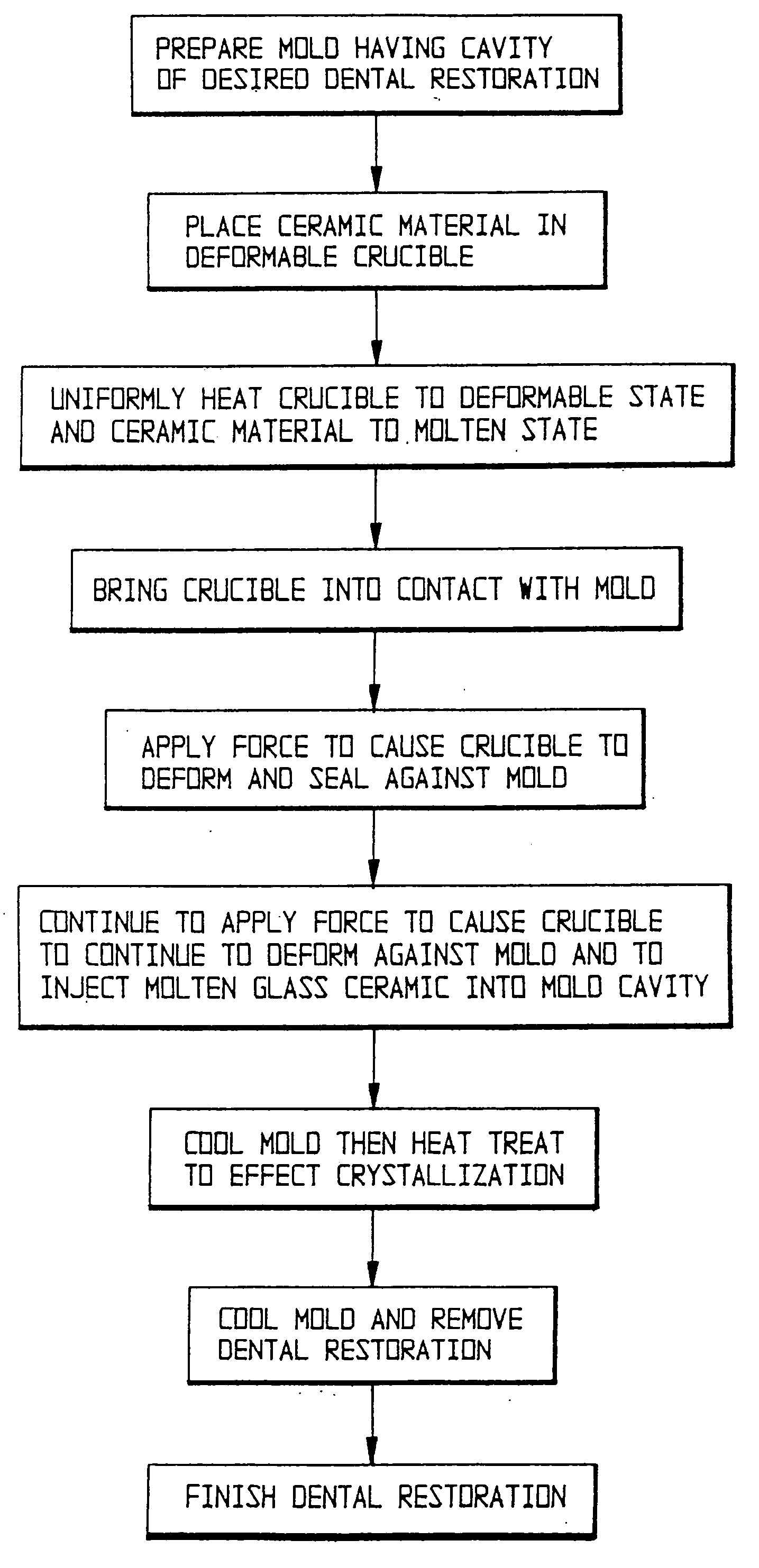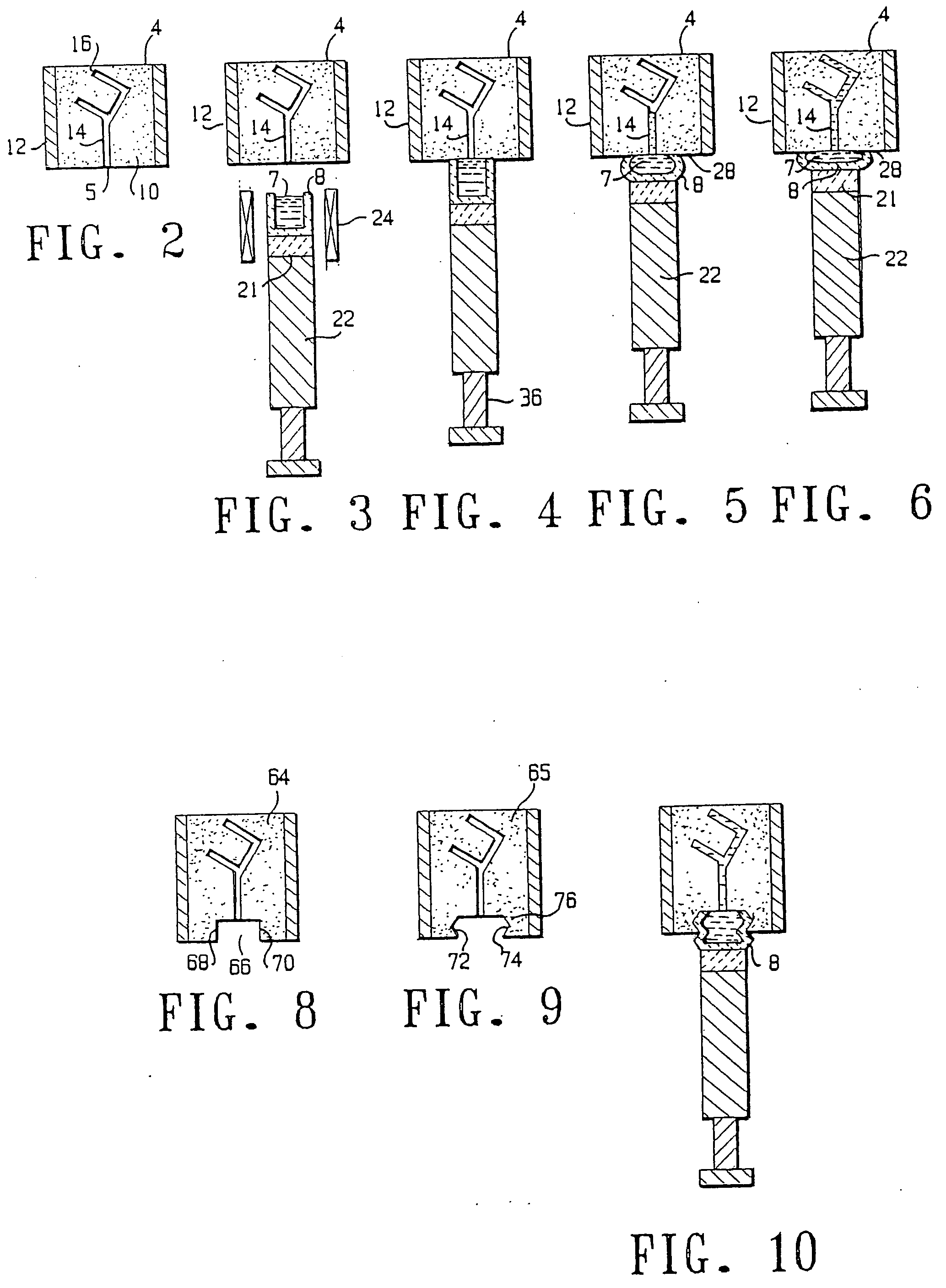Method for molding dental restorations and related apparatus
a dental restoration and mold technology, applied in the field of molding dental restorations, can solve the problems of difficult, if not impossible, to form top quality dental restorations by molding, and achieve the effects of easy use, outstanding strength properties, and easy molding into dental restorations
- Summary
- Abstract
- Description
- Claims
- Application Information
AI Technical Summary
Benefits of technology
Problems solved by technology
Method used
Image
Examples
example 1
[0199] An attempt was made to form a glass-ceramic dental restoration in accordance with the following procedure. A mold was prepared in accordance with the procedure described above.
[0200] By use of slip casting techniques, a crucible was prepared in accordance with the procedure described above by mixing 90.9 grams of SP921 TF glass in 363.2 grams of 3I fused silica with 160 ml of water. After slip casting and drying, the crucible was sintered at a temperature of 1100° C. A glass button weighing 6 grams was then placed in the crucible and preheated to a temperature of 650° C.
[0201] The composition of the glass-ceramic material used is in accordance with composition #1 of Table IV.
[0202] The preheated crucible and glass-ceramic material were then placed in an apparatus which is similar to that shown in FIG. 7, and heated to a temperature of 1400° C. for a period of 10 minutes. The ram was then actuated, and the crucible was brought into contact with the mold in accordance with t...
example 2
[0203] A glass-ceramic dental restoration was prepared in accordance with the following procedure. A mold was prepared in accordance with the procedure described above.
[0204] By use of slip casting technique, a crucible was prepared in accordance with the procedure described above by mixing 136.2 grams of SP921 TF glass and 317.8 grams of 3I fused silica with 160 ml of water. After slip casting and drying, the crucible was sintered at a temperature of 1100° C. A glass button weighing 6 grams was then placed in the crucible and preheated to a temperature of 650° C.
[0205] The composition of the glass-ceramic material used is in accordance with composition #1 of Table IV.
[0206] The preheated crucible and glass-ceramic material were then placed in an apparatus which is similar to that shown in FIG. 7, and heated to a temperature of 1400° C. for a period of 10 minutes. The ram was then actuated, and the crucible was brought into contact with the mold in accordance with the general pro...
example 3
[0212] A mold was prepared in accordance with the procedure described above.
[0213] By use of slip casting technique, a crucible was prepared in accordance with the procedure described above by mixing 181.6 grams of SP921 TF glass and 272.4 grams of 3I fused silica with 160 ml of water. After slip casting and drying, the crucible was sintered at a temperature of 1100° C. A glass button weighing 6 grams was then placed in the crucible and preheated to a temperature of 650° C.
[0214] The preheated crucible without glass-ceramic material was then placed in an apparatus which is similar to that shown in FIG. 7, and heated to a temperature of 1400° C. for a period of 10 minutes.
[0215] During the heating process, the crucible lost its structural integrity, and was not capable of effecting a seal with a mold. Therefore, no molding process was carried out.
PUM
| Property | Measurement | Unit |
|---|---|---|
| softening temperature | aaaaa | aaaaa |
| temperature | aaaaa | aaaaa |
| thickness | aaaaa | aaaaa |
Abstract
Description
Claims
Application Information
 Login to View More
Login to View More - R&D
- Intellectual Property
- Life Sciences
- Materials
- Tech Scout
- Unparalleled Data Quality
- Higher Quality Content
- 60% Fewer Hallucinations
Browse by: Latest US Patents, China's latest patents, Technical Efficacy Thesaurus, Application Domain, Technology Topic, Popular Technical Reports.
© 2025 PatSnap. All rights reserved.Legal|Privacy policy|Modern Slavery Act Transparency Statement|Sitemap|About US| Contact US: help@patsnap.com



